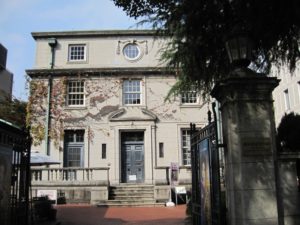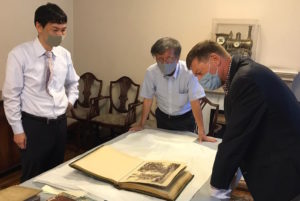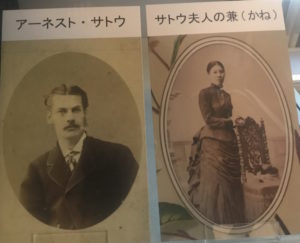29th September 2020 Tokyo, Japan
Former British Consulate in Yokohama
 The former British Consulate in Yokohama is a handsome stone building, reconstructed after the Great Tokyo Earthquake of 1923, just like the Embassy in Tokyo. Its location, amidst the downtown shops and offices of Japan’s second largest city, was once the bustling waterfront where East met West. Yokohama was one of several Treaty Ports, where foreigners were allowed to trade, when Japan reopened to the world after 230 years of isolation in 1854. As the nearest entry point to Tokyo, it was to become by far the most important of them.
The former British Consulate in Yokohama is a handsome stone building, reconstructed after the Great Tokyo Earthquake of 1923, just like the Embassy in Tokyo. Its location, amidst the downtown shops and offices of Japan’s second largest city, was once the bustling waterfront where East met West. Yokohama was one of several Treaty Ports, where foreigners were allowed to trade, when Japan reopened to the world after 230 years of isolation in 1854. As the nearest entry point to Tokyo, it was to become by far the most important of them.
Nowadays the building houses the Yokohama Archives of History, with an impressive collection of documents relating to the Meiji period when Japan was opening up, rapidly modernising, and beginning its journey towards becoming one of the world’s largest economies. Curator Yoshizaki Masaki invited me to visit the archive to see some of the materials that will be included in an exhibition of UK/Japan relations he is planning for next year. Many Britons played prominent roles here during the Meiji period, as advisers, scholars and business people.
 Among them was one of my predecessors, Sir Ernest Satow (1843-1929). Satow was one of the first young British diplomats to arrive in Japan after it opened up. He was to stay for over twenty years, from 1862 to 1883, mastering the language and building strong ties with some of the leaders of the new Japan. His book, A Diplomat in Japan, describes the exciting period when the modernisers, led by the Choshu and Satsuma clans from the far west of Japan, ousted the Tokugawa shogun, and restored the Emperor to his leading role. Satow kept extensive diaries, some of which I have read at the Public Records Office in Kew. Nowadays, many are available in modern publications, thanks to the scholarship of my good friend Ian Ruxton, a professor at the Kyushu Institute of Technology. Satow was to serve in other countries – Thailand, Uruguay, Morocco and eventually China. But it is for Japan he is best known and he was to return as Minister from 1895-1900. In those days our legation in Japan had not yet been upgraded to a full Embassy, but he was effectively the Ambassador.
Among them was one of my predecessors, Sir Ernest Satow (1843-1929). Satow was one of the first young British diplomats to arrive in Japan after it opened up. He was to stay for over twenty years, from 1862 to 1883, mastering the language and building strong ties with some of the leaders of the new Japan. His book, A Diplomat in Japan, describes the exciting period when the modernisers, led by the Choshu and Satsuma clans from the far west of Japan, ousted the Tokugawa shogun, and restored the Emperor to his leading role. Satow kept extensive diaries, some of which I have read at the Public Records Office in Kew. Nowadays, many are available in modern publications, thanks to the scholarship of my good friend Ian Ruxton, a professor at the Kyushu Institute of Technology. Satow was to serve in other countries – Thailand, Uruguay, Morocco and eventually China. But it is for Japan he is best known and he was to return as Minister from 1895-1900. In those days our legation in Japan had not yet been upgraded to a full Embassy, but he was effectively the Ambassador.
 I have a strong interest in Satow because, after retiring, he spent the last twenty years of his life living in a small East Devon market town, Ottery St Mary – where I grew up – and where he was active in many areas of community life. In his days, as a British diplomat, Satow was not permitted to marry a Japanese – quite a contrast to nowadays, when many of my embassy team have Japanese spouses. But he remained faithful to his Japanese partner Takeda Kane and their three children throughout his life. Some years ago I had the pleasure of welcoming his granddaughter Takeda Fumie to my home town, on her first visit to the UK, and was able to show her the home where Satow had lived, and his grave in the local churchyard.
I have a strong interest in Satow because, after retiring, he spent the last twenty years of his life living in a small East Devon market town, Ottery St Mary – where I grew up – and where he was active in many areas of community life. In his days, as a British diplomat, Satow was not permitted to marry a Japanese – quite a contrast to nowadays, when many of my embassy team have Japanese spouses. But he remained faithful to his Japanese partner Takeda Kane and their three children throughout his life. Some years ago I had the pleasure of welcoming his granddaughter Takeda Fumie to my home town, on her first visit to the UK, and was able to show her the home where Satow had lived, and his grave in the local churchyard.
Looking through some of the original documents and photographs from 150 years ago was a fascinating glimpse of Japan at one of its periods of greatest change. I’m sure Yoshizaki’s exhibition is going to be really interesting.